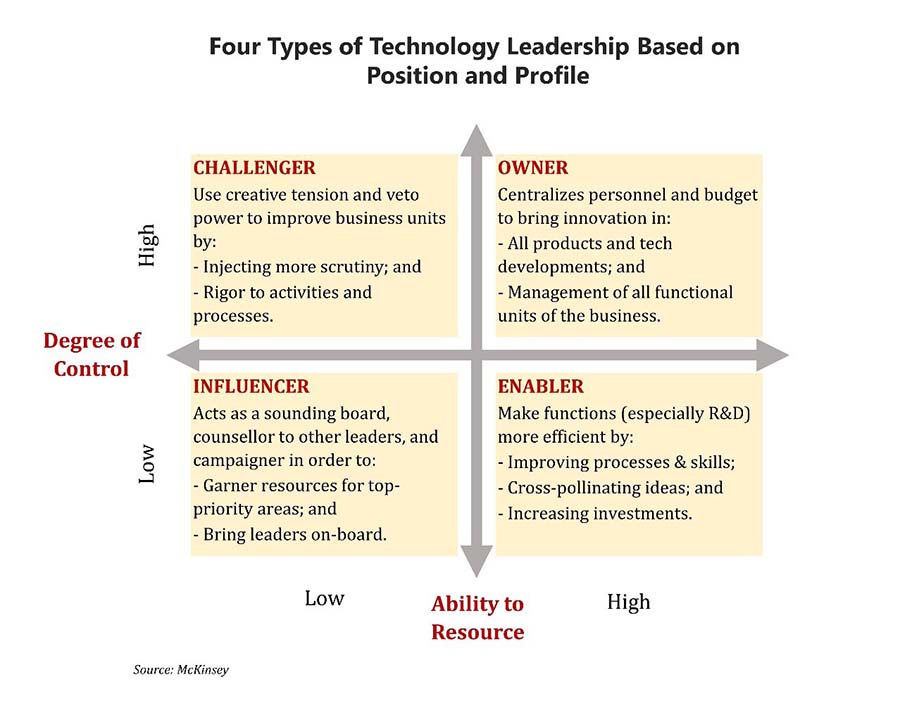Technology and business are inextricably interwoven. No one can talk meaningfully about one without talking about the other.
-Bill Gates
Information technology is transcending boundaries between sectors and industries to create new businesses founded entirely on technology such as Airbnb in the rental marketplace and Amazon in commerce. In addition to external disruptions, there are internal disruptions from technological innovations, which are disintegrating the functional silos and prompting companies to work end-to-end.
From Doblin’s 10 types of innovation modes to the changing nature of business operations due to the pandemic, digitization and technology have a role to play in most business transformations. Tech is leading the agility and flexibility agenda today and is driving business goals. The uphill task for executives and strategists is to attain a perfect alignment between technology and business strategy. In this article, we look at what goes into the making of a technology leader, and why businesses need them.
Historically, businesses focused on hiring either those with strong technical skills and abilities or those with strong people and leadership skills. New age organizations need both – people who can blend technical knowledge with an ability to lead people. They are christened as technology leaders.
A gap exists between what businesses need from leaders in technological understanding and leadership capabilities.
A major reason for this gap is the lack of preparedness among companies. Most organizations don’t have anyone in their C-suite who can own the responsibility of efficiently navigating the technological shifts. According to a survey by McKinsey, 26% of CXOs who were surveyed said there was no clear-cut owner for technological activities within their organizations – such as for identifying and implementing cutting-edge technologies.
Technology leaders are developers (specify and build systems), commercializers (figure out how to make profits), and stewards (get systems built and employed) of technology in an organization.
A technology leader is not only responsible for delivering products, but they ensure the presence of an effective technology-driven ecosystem. When a company misses on important technological inflection points, they are held accountable
The role of leaders with technical competence is evolving for businesses. They:
Understand technology life cycle.
Have know-how of consumer persona.
Are a critical link between technology and strategy.
Assess, manage, and forecast technological innovations, and assist technology transfers.
Are a unifier between people and processes. They are willing to cross-functional silos to seek progressive ways to use technology and data.
View technology as a core aspect of business at all levels, and not just as company’s products or R&D activity.
Based on how much power does a leader has to affect change and long-term value within an organization – four types of technology leaders can be identified by the degree of control and resources at their behest (derived from McKinsey).

Now, which style of technology leader and leadership would best suit a company can vary.
Organizations, which are less tech-intensive can benefit from Enabler and Influencer type of leaderships where a tech leader would likely have a lower degree of control over business agendas but can advocate change.
Enablers tend to be more managerial in approach and focused on improving business efficiency.
Influencers are thinkers who can create space and acceptance within the organization for new technologies and tech-innovation.
Organizations that are highly tech-intensive benefit most from Challenger and Owner type technological leaderships.
Challenger style prevents businesses with multiple units from becoming complacent and continually improves them.
Owner style suits well to those that are in single-product business or where products are of a similar kind (for instance, OEMs).
Further on, enablers and owners are best placed on the ability to resource. This makes them highly focused internally in contrast to challengers and influencers who exert more impact on external environments.
Organizations are looking for consistent and measured growth, and digitization can provide them that. Having technical competence has become a core skill for strategists and business leaders. It is crucial to drive innovation, spot emerging technologies, and reinvent operations.
Technology strategists and leaders, though a rare breed, remain highly coveted. Don’t get left behind because of the lack of expertise and exposure. Reinvent your leadership and develop capabilities to deliver technological stewardship with state-of-the-art business strategy certifications. Bring diverse perspectives from the field of technology and a rich experience to unify C-suite and board members on vital tech needs.

CredBadge™ is a proprietary, secure, digital badging platform that provides for seamless authentication and verification of credentials across digital media worldwide.
CredBadge™ powered credentials ensure that professionals can showcase and verify their qualifications and credentials across all digital platforms, and at any time, across the planet.

Keep yourself informed on the latest updates and information about business strategy by subscribing to our newsletter.